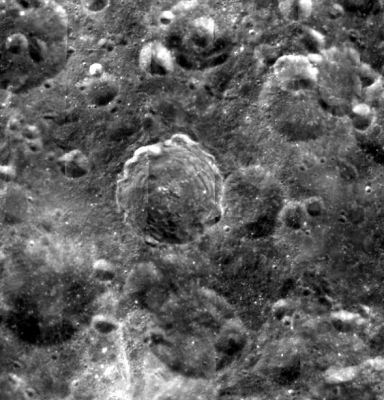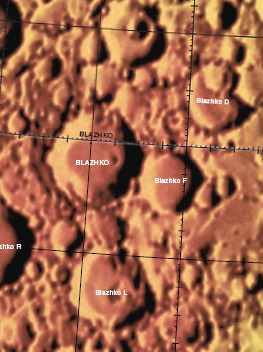Difference between revisions of "Blazhko"
| Line 18: | Line 18: | ||
''([[LAC%20zone|LAC zone]] 52A1)'' [http://planetarynames.wr.usgs.gov/images/Lunar/lac_52.pdf USGS Digital Atlas PDF]<br /> <br /> | ''([[LAC%20zone|LAC zone]] 52A1)'' [http://planetarynames.wr.usgs.gov/images/Lunar/lac_52.pdf USGS Digital Atlas PDF]<br /> <br /> | ||
==Description== | ==Description== | ||
| − | '''Blazhko''' is a crater that formed during the [[Stratigraphy|Late Imbrium]] period (~ 3.85 to 3.15 bn years). It lies on ejecta deposits of the [[Hertzsprung|Hertzsprung Basin]] -- a basin that formed during the [[Stratigraphy|Nectarian]] period (~ 3.92 to 3.85 bn years), and whose centre lies some 1200 kilometes away to the south-east. '''Blazhko's''' rim is somewhat unusual in shape in that most of it has a series of small, semi-cicular-type chunks taken out of it -- particularly around most of its northern section and one or two in the south/south-west. These dislodged chunks may be due to the material make-up in which it formed, or, it may be due to later impacts that occurred nearby causing portions of its rim to landslide inwards (note the terracing all around). '''Blazhko's''' floor must have recieved most of this landfill as only a small amount can just about be seen in the photo above, where there also may lie just a small peak that is just beyond reach of definition. <span style="font-family: Arial"><span class="membersnap">- | + | '''Blazhko''' is a crater that formed during the [[Stratigraphy|Late Imbrium]] period (~ 3.85 to 3.15 bn years). It lies on ejecta deposits of the [[Hertzsprung|Hertzsprung Basin]] -- a basin that formed during the [[Stratigraphy|Nectarian]] period (~ 3.92 to 3.85 bn years), and whose centre lies some 1200 kilometes away to the south-east. '''Blazhko's''' rim is somewhat unusual in shape in that most of it has a series of small, semi-cicular-type chunks taken out of it -- particularly around most of its northern section and one or two in the south/south-west. These dislodged chunks may be due to the material make-up in which it formed, or, it may be due to later impacts that occurred nearby causing portions of its rim to landslide inwards (note the terracing all around). '''Blazhko's''' floor must have recieved most of this landfill as only a small amount can just about be seen in the photo above, where there also may lie just a small peak that is just beyond reach of definition. <span style="font-family: Arial"><span class="membersnap">- JohnMoore2</span></span><br /> <br /> |
==Description: Wikipedia== | ==Description: Wikipedia== | ||
[http://en.wikipedia.org/wiki/Blazhko_(crater) Blazhko]<br /> <br /> | [http://en.wikipedia.org/wiki/Blazhko_(crater) Blazhko]<br /> <br /> | ||
Latest revision as of 20:02, 16 April 2018
Contents
Blazhko
| Lat: 31.6°N, Long: 148.0°W, Diam: 54 km, Depth: km, Rükl: (farside) | |
Images
LPOD Photo Gallery Lunar Orbiter Images Apollo Images
- Dept., of Lunar and Planetary Research, Moscow University, Russia.
Maps
(LAC zone 52A1) USGS Digital Atlas PDF
Description
Blazhko is a crater that formed during the Late Imbrium period (~ 3.85 to 3.15 bn years). It lies on ejecta deposits of the Hertzsprung Basin -- a basin that formed during the Nectarian period (~ 3.92 to 3.85 bn years), and whose centre lies some 1200 kilometes away to the south-east. Blazhko's rim is somewhat unusual in shape in that most of it has a series of small, semi-cicular-type chunks taken out of it -- particularly around most of its northern section and one or two in the south/south-west. These dislodged chunks may be due to the material make-up in which it formed, or, it may be due to later impacts that occurred nearby causing portions of its rim to landslide inwards (note the terracing all around). Blazhko's floor must have recieved most of this landfill as only a small amount can just about be seen in the photo above, where there also may lie just a small peak that is just beyond reach of definition. - JohnMoore2
Description: Wikipedia
Additional Information
Nomenclature
Sergei Nikolaevich Blazhko (November 5, 1870 - February 11, 1956) was a Soviet astronomer. He discovered a secondary variation of the amplitude and period of some RR Lyrae stars and related pulsating variables, now know as the Blazhko effect.
LPOD Articles
Bibliography

